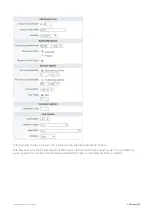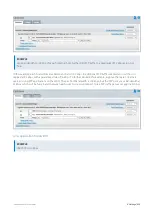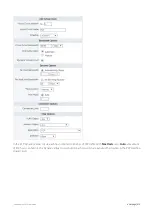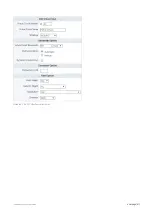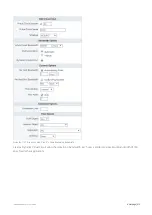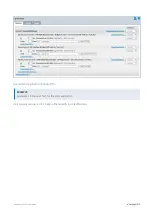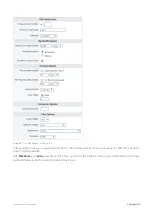
Exinda Network Orchestrator
4 Settings
|
399
upstream service providers with asymmetric routes, where traffic may go out one bridge and return via another bridge. In
this case, dual bridge bypass needs to be disabled so that traffic is handled the same regardless of which bridge it
arrives on.
For acceleration, dual bridge bypass controls where packets are intercepted and passed to acceleration and edge cache.
When enabled, all acceleration processing is performed on one bridge only. This is desirable for backhaul settings
but will cause traffic problems if there is asymmetric routing or link aggregation in use. Consider traffic passing through
the appliance from the WAN to the Internet as:
WAN <-> br10 <-> router <-> br20 <-> inter-
net
For an incoming accelerated connection, the acceleration processing happens on the first WAN interface to
see the SYN. In this case, where the connection is going to the internet, the accelerated connection would be
processed on br10. That same traffic when seen on br20 would then be passed though untouched (the traffic
'bypasses' br20).
For an outgoing accelerated connection, the acceleration processing happens on the first bridge with a
matching acceleration policy. In this case, where the connection is from the Internet, if there is an acceleration
policy on br20, the acceleration policy happens on br20 and the traffic would be untouched on br10. Or if the
acceleration policy was on br10, then the traffic would be passed through br20 untouched and accelerated on
br10.
When disabled, acceleration processing is performed on whatever bridge it arrives on.
This is desirable for asymmetric routing or link aggregation, where you want traffic to switch bridges. However, in an
accelerated backhauled scenario, the accelerated traffic cannot switch bridges and still function properly. The SYN from
the client must be processed on the same bridge as the SYN/ACK from the server.
For monitoring, dual bridge bypass controls how flows are tracked and how flows appear in the real-time monitor.
When enabled, the same flow is tracked separately on each bridge. This allows you to see the different policies and
transfer rates that are being applied on each bridge in the real-time monitor.
This may be desirable when you have dual bridge bypass for acceleration enabled so that you can see all the policies
applied to the flows. If traffic is both accelerated and edge cached you see the two separate flows in real-time, but they
will not be coloured yellow and blue to indicate acceleration and edge cache. They will both be coloured the one of
the two colours.
If you see the (A) symbol in the real-time monitor and you get asymmetric route warnings, either the appliance is not
seeing half of the flow or the other half of the flow is on another bridge, where the flow is bypassing acceleration
processing on the second bridge and therefore you need to disable dual bridge bypass for acceleration for it to work
properly.
If you have two circuits configured on the Exinda such that traffic between the headquarters appliance and the branch
appliance goes through one circuit and the traffic between the headquarters appliance and the internet goes through
a second circuit, then the traffic for a single flow will be counted in the appropriate virtual circuit for each circuit.
When disabled, the same flow through two different bridges will be shown as one merged flow. The real-time mon-
itor will only show the policy of the last packet processed.
When doing load balancing, failover, link bonding, or seeing asymmetric routes (either locally or in a HA cluster), you will
want to turn off the monitor dual bridge bypass function to get back to a merged view of all flows.
Modifying the Dual Bridge Bypass settings
To modify acceleration settings:
1.
Go to
Configuration > System > Optimization > TCP
.
2.
Modify the
Dual-bridge bypass
setting. If checked, it is enabled.
To modify monitoring settings:
Summary of Contents for EXNV-10063
Page 369: ...Exinda Network Orchestrator 4 Settings 369 ...
Page 411: ...Exinda Network Orchestrator 4 Settings 411 Screenshot 168 P2P OverflowVirtualCircuit ...
Page 420: ...Exinda Network Orchestrator 4 Settings 420 Screenshot 175 Students OverflowVirtualCircuit ...
























